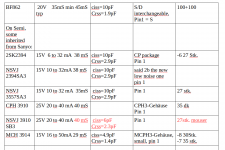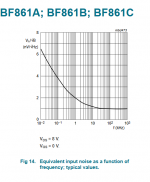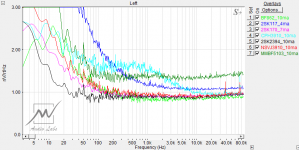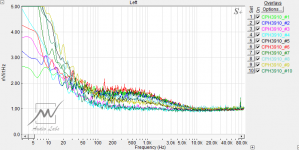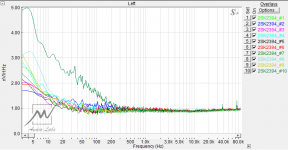Hi guys,
as the title say's, I need original BF862 for a project I'm working on.
Interested in quantities of +100pcs and more.
Anybody care to share their stash or point me to a seller that is legit ?
Currently I have more then 1k fake jfets laying on my table from failed attempts on eBay and Ali and although I got refunds for most of them this is getting really frustrating
You guys are my last hope
as the title say's, I need original BF862 for a project I'm working on.
Interested in quantities of +100pcs and more.
Anybody care to share their stash or point me to a seller that is legit ?
Currently I have more then 1k fake jfets laying on my table from failed attempts on eBay and Ali and although I got refunds for most of them this is getting really frustrating
You guys are my last hope
BF862 were obsolete from NXP back in 2005.
RS have equivalents; RS Components | Electronic and Electrical Components
RS have equivalents; RS Components | Electronic and Electrical Components
Yep, and at that time I had like 200pcs in my stock and thought "it will last me forever". Well, it didn't...BF862 were obsolete from NXP back in 2005.
Thanks for the link, unfortunately BF510 has x10 times less trans-conductance and noise figures are nothing to write home about. As far as I can tell, nothing in current production can come close to BF862 noise wise.RS have equivalents; RS Components | Electronic and Electrical Components
I just thought it would be easier to source them...
On Semi has a few that can hold the candle to the BF862.
(from my notes-file)
Thanks Gerhard!
I was considering 2SK2394 as it can do 1.6nV/SqrtHz on a good day, and live with x2 noise penalty ref. BF862. But somehow I totally missed CPH3910
Are there any differences apart the package with CPH3910 and NSVJ3910SB3 ?
Datasheets look identical. Couldn't find any noise measurements though, maybe you have made some?
Probably the same chip in CPH housing, slightly smaller than SOT-23 IIRC.
Noisewise the figure of merit is the ratio of capacitance to gm. both what
affects a single transistor and the freedom you have to parallel more of them.
I have spent too much time with Interfet IF3602 (Mouser). Too much C.
I have them all here, but not yet measured. Must first get the FFT analyzer
back under software control.
Noisewise the figure of merit is the ratio of capacitance to gm. both what
affects a single transistor and the freedom you have to parallel more of them.
I have spent too much time with Interfet IF3602 (Mouser). Too much C.
I have them all here, but not yet measured. Must first get the FFT analyzer
back under software control.
We used the 862 on a phonostage and soon realised that the only ones available were fakes.Hi guys,
as the title say's, I need original BF862 for a project I'm working on.
Interested in quantities of +100pcs and more.
Anybody care to share their stash or point me to a seller that is legit ?
Currently I have more then 1k fake jfets laying on my table from failed attempts on eBay and Ali and although I got refunds for most of them this is getting really frustrating
You guys are my last hope
We swapped to this one, which we believe is as good
BF861C,215 NXP Semiconductors | Mouser United Kingdom
Are there any differences apart the package with CPH3910 and NSVJ3910SB3 ?
The packages seem to be the same. The difference is that OM Semi parts with the NSV prefix are qualified for automotive use.
Probably the same chip in CPH housing, slightly smaller than SOT-23 IIRC.
Noisewise the figure of merit is the ratio of capacitance to gm. both what
affects a single transistor and the freedom you have to parallel more of them.
I have spent too much time with Interfet IF3602 (Mouser). Too much C.
I have them all here, but not yet measured. Must first get the FFT analyzer
back under software control.
Ok, thanks again for a heads up. I ordered all 4 of them. My test rig is pretty much up and running so I will have noise results in a couple weeks or so and will post them here.
We used the 862 on a phonostage and soon realised that the only ones available were fakes.
We swapped to this one, which we believe is as good
BF861C,215 NXP Semiconductors | Mouser United Kingdom
As gerhard already pointed out, high 1/f corner is a no go for me. In your application RIAA curve kinda mitigates that so maybe you are able to get away with it. Good thing they specify it in a datasheet...
Attachments
Oh I see what he meant.Ok, thanks again for a heads up. I ordered all 4 of them. My test rig is pretty much up and running so I will have noise results in a couple weeks or so and will post them here.
As gerhard already pointed out, high 1/f corner is a no go for me. In your application RIAA curve kinda mitigates that so maybe you are able to get away with it. Good thing they specify it in a datasheet...
Right, I'd better look myself lol.
Good luck!
The packages seem to be the same. The difference is that OM Semi parts with the NSV prefix are qualified for automotive use.
Yep, same SC-59. One Pb-Free, other not. So same, but different
Oh I see what he meant.
Right, I'd better look myself lol.
Good luck!
Thanks! At this point I feel like I need it
Poor for audio, especially phono.Is that good or bad?
There is nothing in a jfet design that would cause high 1/f, this is a process thing, so it could improve with production experience.
The only non-cleanliness mitigation is burying the junction
Hmm, that's a concernPoor for audio, especially phono.
There is nothing in a jfet design that would cause high 1/f, this is a process thing, so it could improve with production experience.
The only non-cleanliness mitigation is burying the junction
Poor for audio, especially phono.
There is nothing in a jfet design that would cause high 1/f, this is a process thing, so it could improve with production experience.
The only non-cleanliness mitigation is burying the junction
The BF862 is an RF device and I couldn't see a 1/f knee on the datasheet - is it specified?
The 1/f knee is the frequency below which the 1/f noise rises up from the thermal noise floor at 6dB/octave. For audio you'd like it below 20Hz, or at least below 100 or so. If you don't care then knees can be around 10kHz or even higher.
For RF the 1/f knee is often irrelevant except for oscillators and high level mixing where it directly affects the phase-noise. Any device designed as an RF oscillator or mixer is likely to have well specified low frequency noise.
1/f noise is related to defects in the device, especially at interfaces between materials and surfaces. A pn-junction is not an interface in this sense, but a MOS device is. In BJTs and JFETs normally the surface of the device is the main source of 1/f noise which is why you can bury the device to reduce the problem.
Measurement results
As saying goes - it's better late then never.... So here it goes.
First graph (see attached) shows how a current production JFET’s stack up in comparison to mighty BF862.
Seems like BF862 still holds ground as having lowest overall noise level, but 2SK2394 has much better 1f corner! Actually it’s best I have ever seen from a JFET or BJT for that matter, a really spectacular part! And it’s noise floor is maybe some 0.1nV/rtHz higher. I say maybe, because I must admit this falls into my calibration/measurement uncertainty. So for my intended applications 2SK2394 seems like a clear overall winner and my new favorite. I also have 2SK3557 on order. It looks like the same silicon as 2394 just lower trans-conductance, so I don’t expect any improvements. I will make an update when I measure them (don’t hold your breath though).
Second graph shows how these modern parts look compared to older favorites like 2SK170.
NSVJ3910 seems like a good match for 2SK170. Almost identical noise spectrum’s, but it has twice as much trans-conductance (22 vs. 40 mS) and five times lower input capacitance! (6 vs. 30pF). So a huge overall improvement over now legendary 2SK170. Also, negligible NSVJ3910 input capacitance makes this part most attractive in terms of paralleling then any other JFET measured here. Just a word of caution – it was the ONLY part that decided to be ~350Mhz oscillator instead of amplifier in my measurements. So care must be taken to isolate gate appropriately for the application.
Most strangest result is the difference between NSVJ3910 and CPH3910. It’s suppose to be same silicon in different package, but CPH3910 has this hump from 100Hz to 9Khz. Now I’m not an semiconductor process expert, but it looks like some manufacturing impurity to me. This could be just my batch (Farnell 2020.06 stock) or it could be how this part really is.
I made some distribution measurements to see if this is consistent defect in my batch (third attachment). It's a noise spectrum of 10 random samples from a batch of 40 pcs. Seems like 70% of samples are affected to some degree.
For comparison: fourth attachment is 10 samples of 2SK2394 (from a batch of 40). Almost ideal parameter spread except one “fluke”. This just shows again that for a really noise-critical applications, hand selection is the only way to go.
I have made much more measurements with different currents/older parts and not only JFET's. If interested they can be found at my website:
Modern JFET noise measurements - MV Audio Labs
As saying goes - it's better late then never.... So here it goes.
First graph (see attached) shows how a current production JFET’s stack up in comparison to mighty BF862.
Seems like BF862 still holds ground as having lowest overall noise level, but 2SK2394 has much better 1f corner! Actually it’s best I have ever seen from a JFET or BJT for that matter, a really spectacular part! And it’s noise floor is maybe some 0.1nV/rtHz higher. I say maybe, because I must admit this falls into my calibration/measurement uncertainty. So for my intended applications 2SK2394 seems like a clear overall winner and my new favorite. I also have 2SK3557 on order. It looks like the same silicon as 2394 just lower trans-conductance, so I don’t expect any improvements. I will make an update when I measure them (don’t hold your breath though).
Second graph shows how these modern parts look compared to older favorites like 2SK170.
NSVJ3910 seems like a good match for 2SK170. Almost identical noise spectrum’s, but it has twice as much trans-conductance (22 vs. 40 mS) and five times lower input capacitance! (6 vs. 30pF). So a huge overall improvement over now legendary 2SK170. Also, negligible NSVJ3910 input capacitance makes this part most attractive in terms of paralleling then any other JFET measured here. Just a word of caution – it was the ONLY part that decided to be ~350Mhz oscillator instead of amplifier in my measurements. So care must be taken to isolate gate appropriately for the application.
Most strangest result is the difference between NSVJ3910 and CPH3910. It’s suppose to be same silicon in different package, but CPH3910 has this hump from 100Hz to 9Khz. Now I’m not an semiconductor process expert, but it looks like some manufacturing impurity to me. This could be just my batch (Farnell 2020.06 stock) or it could be how this part really is.
I made some distribution measurements to see if this is consistent defect in my batch (third attachment). It's a noise spectrum of 10 random samples from a batch of 40 pcs. Seems like 70% of samples are affected to some degree.
For comparison: fourth attachment is 10 samples of 2SK2394 (from a batch of 40). Almost ideal parameter spread except one “fluke”. This just shows again that for a really noise-critical applications, hand selection is the only way to go.
I have made much more measurements with different currents/older parts and not only JFET's. If interested they can be found at my website:
Modern JFET noise measurements - MV Audio Labs
Attachments
I have made much more measurements with different currents/older parts and not only JFET's. If interested they can be found at my website:
Modern JFET noise measurements - MV Audio Labs
Great work, thanks!
- Home
- Design & Build
- Parts
- Reliable source for BF862 ?
